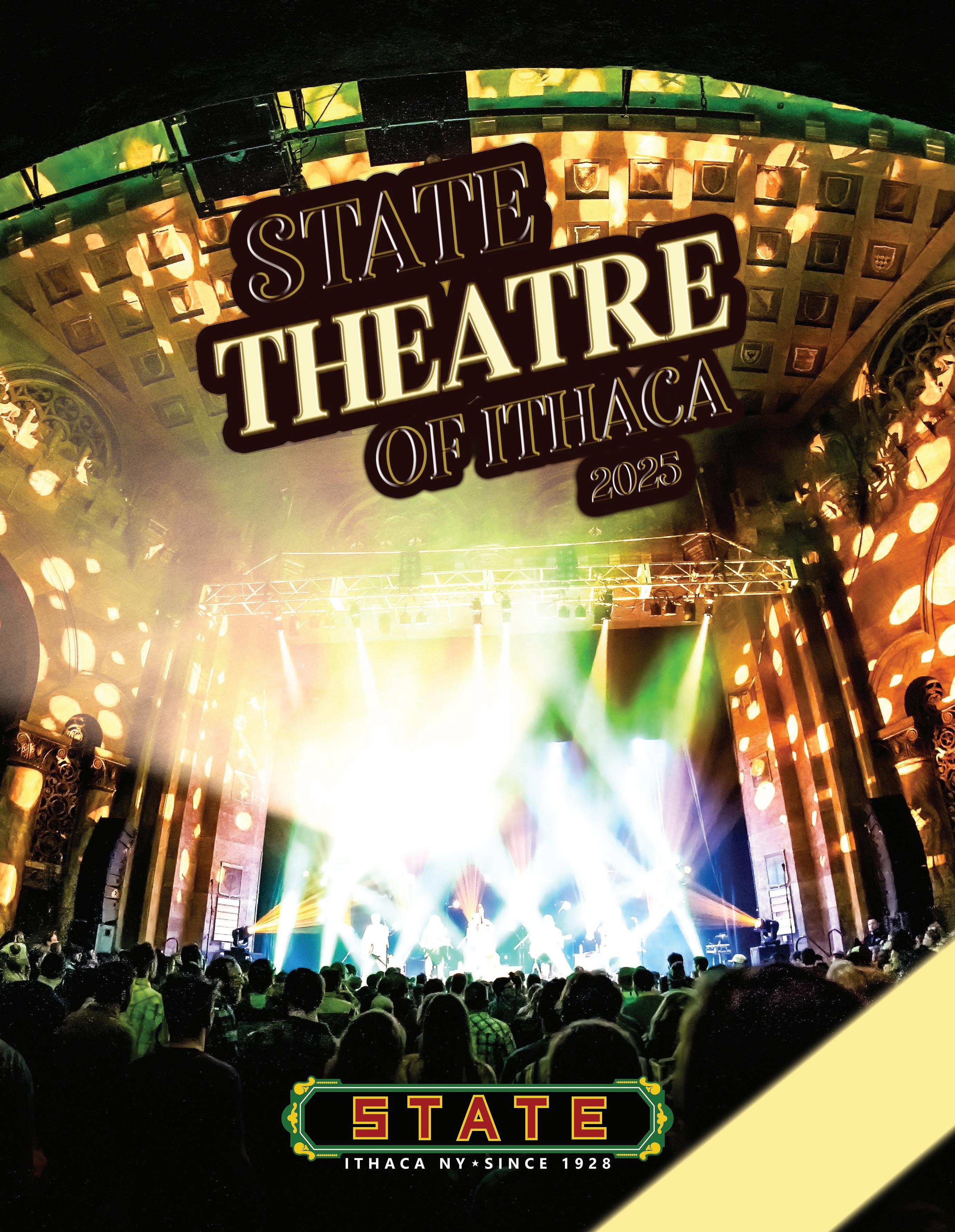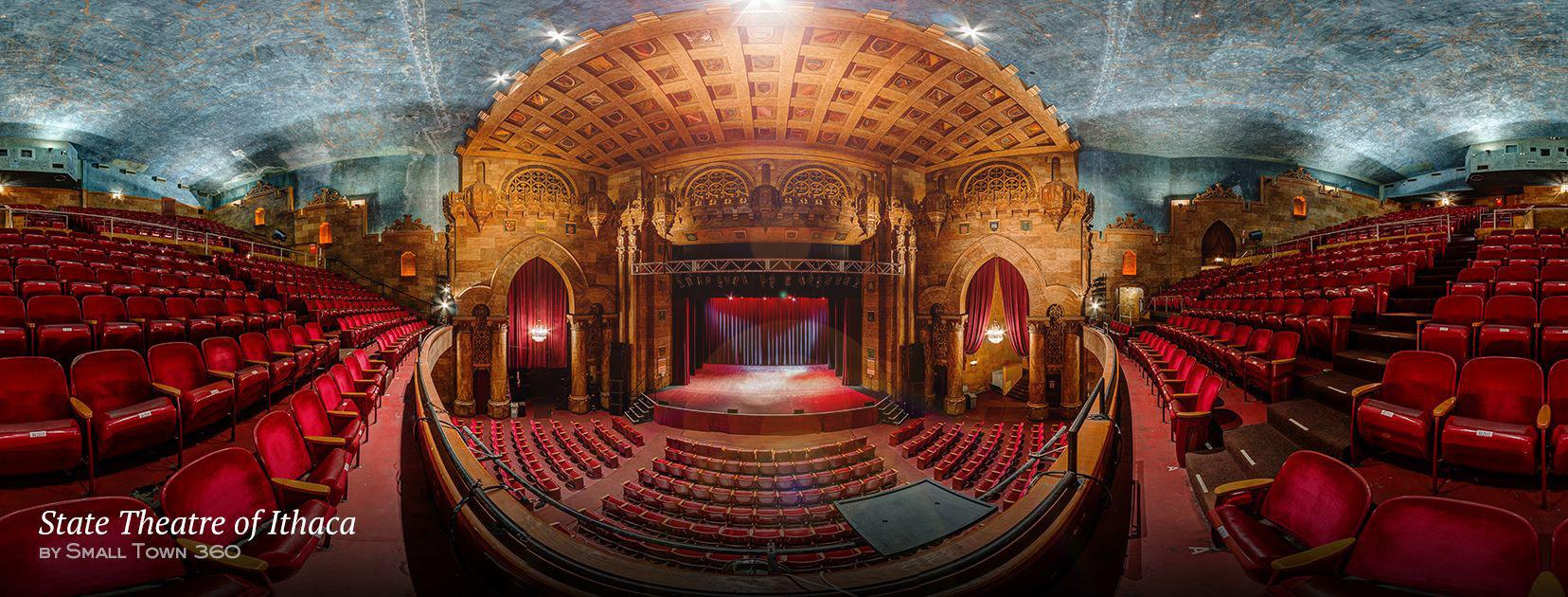WELCOME TO YOUR STATE THEATRE OF ITHACA!
To our community of State Theatre supporters,
The other night, I was attending the Neko Case show in our beautiful theater and two things caught my attention. The first, was midway through the show when I got up from my seat to grab a drink from our new concessions space on the first floor. On my return to our seats in the balcony, I saw a family of four, including two young girls walking down the steps. The girls were wearing sequin dresses and boas and had the biggest smiles on their faces. They were leaving early because of the time, but clearly this was an event to get dressed up for and they looked so proud to be out on the town past bedtime. The second was a comment from Neko Case herself before her last encore set. “You all are so lucky to have such a beautiful theater in your town,” she said. To which I couldn’t help but put on my board hat and yell, “Become a member!”
But these aren’t the only moments that paint a picture of what makes this theater special. Earlier this year, Dr. Nia Nunn, another Ithaca treasure and State Theater board member held a series of events around Black History Month. She shared two films about black history and invited the community to watch, listen and then have a discussion about a subject we can all be discussing a lot more. I attended one of her talks with my oldest son and afterwards he said, “We should go to more things like this together, Dad.”
And then I think back to last year’s annual “Benefit My State, Variety Hour”, hosted by Amy Dickinson and Dan Smalls, with special guests like Sam Harris, Ritche Stearns, Galumpha and Running to Places. This event was a love-fest for the theater, with each act performing and then sharing stories about their history with the State. Perhaps the most poignant was a mom sharing the story of her neurodivergent non-verbal child seeing his first performance at the State and how it changed all of their lives when they witnessed his love for music and theater. This same kid is now acting with Running to Places and will be performing on stage at the State Theatre.

But perhaps the greatest sign of our community’s appreciation for this space was the 1,600 $100 donations we received during COVID that helped to save our theater from closing. Each person that made a donation, not only left a physical mark on the theater with their name engraved on a seat, but they showed what can be done when we come together to support something so special and central to the fabric of our community.
I joined the State Theatre board and agreed to serve as president because I know this theater means so much to each of you reading this. Like me, you’ve had moments that can only be described as a connection to strangers around you. That pause during a concert when you look around and feel a part of your community and are proud of it. And we know we can do so much more. We have big ideas for how we can improve the experience in our theater and how we can take advantage of many more
events in this space. We will continue to upgrade our sound, lighting and seating. We will diversify our shows to be sure that everyone has a seat at the table to enjoy our programming. And as we approach our 100-year anniversary, we will do everything we can to set this building up for its next hundred years as we adapt to the future of theater experiences.
So, thank you! Thank you for showing up to support our historic theater. From buying tickets to a show, being an employee of the State, giving your volunteer time or donating to keep this theater opperating, it truly takes a village to keep a building of this size and cost running. And while you may see a packed show and assume we are in great shape; the truth is that only a small portion of your ticket purchase comes to us. The theater survives through the concessions you purchase, the donations you make and our community sponsors. So, if you want to help us continue to evolve and be here for the next 100 years, please join our membership program TODAY. There is no better way to help than to select a membership level that fits for you, and to show your support through an annual donation to this incredible staple in our community. Visit our membership link at https://stateofithaca.org/membership/ and once you sign up, you’ll get first choice of seats for your next show among many other benefits.
And finally, if you have ideas on how we can improve, please reach out to us directly. We are always looking for new volunteers, committee members and board members. Or we would just love to hear your own stories, and what we can do to make this theater an even greater part of our community and lives.
Thank you,
Ethan Ash State Theatre Board President
Looking West on State Street. Summer, 1957
Photo Courtesy of The History Center in Tompkins County
At M&T Bank, we understand how important art is to a vibrant community. That’s why we offer our time, energy and resources to support artists of all kinds, and encourage others to do the same. Learn more at mtb.com.
Equal Housing Lender. ©2017 M&T Bank. Member FDIC.
MEET YOUR STATE THEATRE STAFF
Doug Levine Executive Director
In the Spring of 2009, State Theatre of Ithaca, Inc. was formed as a stand-alone not-for-profit organization charged with owning, operating and stewarding downtown Ithaca’s last remaining historic performing arts venue. Doug Levine was brought in shortly thereafter and named as this organization’s first Executive Director. Over that time, The State Theatre of Ithaca has raised and invested over $5 million, preserving the theatre’s iconic, historic charm while improving safety and comfort for the 50,000+ patrons that visit every season. Some of the completed projects Levine is most proud of include the new restrooms in the 2nd floor of the lobby, the conversion of the old box office into a new bar & concessions space, tripling the number of accessible seats and replacing all of the boilers throughout the building. With The State Theatre’s Centennial approaching in 2028, we have identified a number of future projects such as a complete energy efficient overhaul of the stage lighting system, replacing all of the roofing throughout and finally adding air conditioning to increase usage and comfort. We look forward to continued community support as we remain at the center of downtown Ithaca’s revitalization.


A native of Sayre, PA, Michael comes to the State Theatre of Ithaca with a strong finance background and an emphasis on exceptional customer service. With over 28 years of executive level experience serving as past CEO, President, and General Manager of both for-profit and not-for-profit companies, he also has a love for live music and historic theatres. Michael has also served his community on many non-profit boards, including tenures of Treasurer of the Board and Director of Marketing and Development for the Bradford County (PA) Regional Arts Council, which had three historic theatres under its stewardship. Michael attended Bloomsburg University of Pennsylvania for a BSBA in Finance and also completed the MBA program at Binghamton University.
Rachel Grant began her time at the State Theatre as a volunteer after graduating from college with a degree in Music Business. She had the opportunity to join the staff two years later in the role of Audience Services Manager, managing the volunteer core, working shows, and fielding calls in the Box Office. In October of 2019, Rachel went on to accept the brand-new position of Development Coordinator, overseeing the administrative functions of fundraising and donor relations’ efforts for the State Theatre. Now over seven years later, she uses her knowledge of the industry and passion for live music to support the State Theatre in its effort to raise funds to allow them to enhance the cultural experience of the community and surrounding regions.
Michael Viselli Business Manager
Rachel Grant Development Coordinator
Casey Martin Director of Marketing
Originally from Rochester, NY, Casey decided to call Ithaca home in 2010 after graduating from Ithaca College with a degree in Audio Production from the Park School of Communications. Casey joined our dedicated staff at The State to manage the box office in 2012. These days he serves as the Director of Marketing and Communications, and manages the operations in the new bar space. Casey also serves as in house photographer capturing all the amazing performances at the State Theatre. When he’s not at The state you can find him shooting photos for the Ithaca Voice, working on his golf game or cheering on the Buffalo Bills.
Sarah Flenders Event Manager
Adam Zonder is thrilled to be joining the staff at the State Theatre after 27 years as the Production Manager of the Hangar Theatre Company. Adam was an Associate Professor and Chair of the Department of Theatre at the University at Albany – SUNY, where he also served as the Production Manager and Technical Director. Additional work with students includes as a Lecturer for Ithaca College and Siena College, and as a guest instructor with Bucknell University, Alfred University, University North Carolina – Chapel Hill, and Kent State University. Adam loves working with artists and clients to produce the best possible events. Outside of work he is a die hard Red Sox and Patriots fan, and loves UCONN basketball (both men’s and women’s). Go Huskies! He also spends time with his family – Renee, Taryn, and Genevieve.
Sarah Flenders discovered her passion for the entertainment industry in 2008 through organizing community fundraisers for public schools, disaster relief, and local businesses. She honed her skills in event management during her nearly five years at Tag’s in Big Flats, NY, where she oversaw the Front of House, Marketing, Staffing, and major seasonal events like Tagsylvania. In 2023, Sarah created the blueprint for Corning Pride Festival, growing the event to over 3,500 attendees with 80+ vendors, interactive workshops and performances at local venues such as The Corning Museum of Glass. Now, she is thrilled to be celebrating 5 years at the State Theatre of Ithaca, where she is dedicated to enhancing the guest experience, ensuring safety, and fostering a welcoming environment for all who visit.
Adam Zonder Production Manager
A BRIEF HISTORY OF THE STATE THEATRE
By Cory Ryan Earle
As one of the region’s most significant and historic arts venues, The State Theatre of Ithaca is proud to commemorate its 90th anniversary with a celebration of local music and performers. The historic building has long served the community as a gathering place, dating back to its earliest days as a garage and car dealership.
Opening Act
Less than a decade after the first Ford Model T rolled off the assembly line, The Ithaca Journal announced construction of an automobile garage at 107-119 W. State Street on June 8, 1915. Although advertisements for the garage began appearing in November, construction was completed by end of December. The building’s architect, Henry N. Hinckley, had graduated from Cornell University’s College of Architecture only four years earlier. Born in Trumansburg, Hinckley would have a long career in Ithaca as a banker, city building commissioner, residential property manager, and antique collector. His home at 410 E. Seneca Street became the Hinckley Foundation Museum after his death in 1969. The fireproof garage was a two-story (plus basement) building of buff-colored brick with a copper front and large plate-glass windows. Built by the Ithaca Security Company, a mortgage and real estate firm, the building was called the Security Garage and leased to the Bovard Brothers, who advertised it as “all that the name implies” and “the most complete repair shop in Central New York.” In addition to offices and showrooms, the building also contained a machine shop, paint shop, and


vulcanizing plant with an electric elevator to move vehicles between levels. A compressed air system for inflating tires was available both curbside and inside. With capacity for 200 cars, the garage sold brands like Overland, Willys-Knight, Oakland, KissleKar, Cole Eight, and Detroit Electric, bringing electric vehicles to Ithaca long before the introduction of charging stations and the Tesla Roadster. The vehicle repairs and sales were supplemented by a livery and taxicab service. The building also housed the Universal Motor Company sales room and service station for Ford automobiles, claiming that “a complete car can be built from parts in our stockroom.” By 1919, these businesses were replaced by The Finger Lakes Garage, Inc., which sold Franklin, Overland, and Studebaker automobiles while advertising skilled mechanics and quick service.
The building was also used for community functions and meetings. It served as a polling place for the first district of Ithaca’s second ward, which now votes at the Greater Ithaca Activities Center. As early as February 1916, the Security Garage hosted an Ithaca Board of Commerce banquet. As possibly the building’s first major musical event, the banquet was followed by a performance of the Bakeshop Orchestra under the direction of S. H. Ayer, a Class of 1914 Cornellian who wrote the music and lyrics for the school song “Cornell Victorious.”
From Sales Floor to Stage
The 1920s saw the growing popularity of large, ornate “movie palaces.” The era of silent films, such as those produced in Ithaca by Theodore and Leopold Wharton from 1914 to 1919, was transitioning to “talkies” following the popularity of The Jazz Singer in 1927. At the time, Ithacans could view movies at downtown theaters like the Lyceum, Crescent, and Strand. In 1928, the Finger Lakes Garage relocated to 110 W. Green Street. The State Street building was sold to Cornell Theaters, Inc., a group of Elmira investors who planned to open a new theater in Ithaca. The corporation was led by Lewis Henry, a 1909 Cornell graduate who briefly served in the U.S. House of Representatives to fill a vacancy from 1922 to 1923. After failing to win reelection, he returned to his legal career and business interests in Elmira. Henry joined with an associate at his law firm, Arthur F. McCann, a 1916 Cornell graduate and son of a noted Elmira judge. Henry and McCann also included experienced theater owners Harry and Benjamin Berinstein. Only two years earlier, the brothers had taken over management of a new theater in Elmira, today known as the Clemens Center. By 1928, they owned and operated seven theaters ranging across New York from Dunkirk to Elmira to Albany.
Collegiate Gothic styles. A steam shovel was used to excavate the orchestra pit and 150 tons of steel girders were removed from the building. Furnishings and equipment were provided by a number of local businesses. The Schumann baby grand piano came from Hickey’s Music Store and the neon sign from Flexlume Signs of Buffalo, both still in business today. Ithaca’s Rothschild’s Department Store provided the seats. The organ, the largest ever provided to a theater by the Link Organ Company of Binghamton, cost approximately $26,000, had around 2,000 pipes, and used 20,000 feet of wiring. The Link Organ Company ceased production the following year, making it one of their last.

The conversion of the garage into a majestic theater was led by architect Victor Rigaumont, who had recently completed extensive renovations to what is now the Lucille Ball Little Theatre in Jamestown, NY. Rigaumont designed or renovated more than forty theaters throughout the northeast during his career, an enterprise that he called the “Gold Rush Theatre Building Business.” Some of Rigaumont’s remaining buildings include the Smith Opera House in Geneva, NY; Barrow Civic Theater in Franklin, PA; Erie Playhouse in Erie, PA; and Oaks Theater in Oakmont, PA. The construction was completed by a local firm owned by Jes J. Dall, Jr., a Cornell classmate of McCann who constructed buildings throughout Cornell, Ithaca, and Cayuga Heights.
Although the garage’s exterior remained largely unchanged besides the addition of a marquee and ticket booth, Rigaumont transformed the interior with a mixture of Moorish, Renaissance Revival, and
The new facility included 3,100 light bulbs, 2,012 letters for the marquee, 1,818 seats, 32 drop sets for vaudeville productions, and 8 dressing rooms. The iconic neon sign outside with red letters and a green border, considered the largest in the Southern Tier at the time, was so unique that newspapers included scientific explanations of neon lighting, noting that it was “invented in Europe and is now used almost exclusively on Broadway.” Rigaumont also introduced elements of atmospheric theaters, a popular trend at the time. The ceiling was dotted with lights to simulate twinkling stars along with a cloud machine to add further ambiance. Constellations of the Zodiac completed the ceiling design.
Inspired by Ithaca’s “educational atmosphere,” Rigaumont incorporated collegiate symbolism throughout the interior. Along the left and right sides of the stage are emblems representing the eight individual colleges of Cornell University (as of 1928), while directly above the stage are six shields for Navy, Harvard, the University of Pennsylvania, the Carnegie Institute of Technology (Rigaumont’s alma mater, now Carnegie Mellon University), Yale, and Army. Emblems representing the United States are on the left wall to the side of the stage, with emblems for Oxford University and two of its colleges on the right wall. The ceiling showcases emblems of over 60 other colleges and universities, with Cornell University’s emblem front and center. Windows throughout the building include stained glass designs depicting the insignia of Cornell fraternities and honor societies.
Curtains Up
With opening night set for Thursday, December 6, 1928, workmen rushed to complete the renovations and interior decorations on time. The newly-hired general manager for the theater, Joseph Saperstein, arrived in Ithaca on the Saturday before opening, leaving his job as manager of Harmanus Bleecker Hall in Albany. Saperstein had started his theater career as a program boy at the Rand Opera House in Troy, NY, before owning a circuit of theaters in Connecticut and serving as president of the Theater Owners of Connecticut.
The Cornell Daily Sun dedicated five full pages to articles and advertisements about the State Theatre on opening day, with details on the design, construction, management, and performers. The paper’s editorial read: “To the new State Theater which is throwing wide its doors this evening, we open our hearts and our purse. Magnificent and splendid without a trace of garishness or tinsel, this stately dignified theater is easily Ithaca’s loveliest building.” Twenty Cornell students in tuxedos were hired as ushers. With doors opening at 6:00 p.m., tickets priced at 50 cents sold out within the hour for the opening performance at 6:45 p.m.
The evening began with an organ recital by noted organist Harry Springer, followed by newsreels, and then remarks by Joseph F. Hickey, secretary of the Chamber of Commerce and founder of Hickey’s Music Center. Theater corporation president Lewis Henry gave remarks on behalf of the theater. The main event was Paul Tremaine and his Aristocrats of Modern Music, a dance band of 21 “peppy, snappy entertainers” described in advertisements as “rhythm running riot,” an avalanche of melody,” “synco-symphonic-syncopation,” and “something different every minute.” Tremaine’s ensemble had performed throughout the country, making a name for itself as jazz’s popularity grew. For the theater opening, they featured singers and dancers the Swift Sisters (Helen and Mary), Johnny Scott, and Ruth Ford. The live performance was followed by a showing of Show Girl, a silent comedy-drama film that had debuted in Sep-
tember. Based on a novel of the same name by J. P. McEvoy, the film starred Alice White as aspiring Broadway star Dixie Dugan.
With a second performance of the “gala bill” of live music and film scheduled for 9:00 p.m., crowds began to gather outside before the first show had finished, with one report noting that attendees “overflowed the sidewalk outside the theater and blocked traffic on West State Street.” The show was staged twice per night that Thursday, Friday, and Saturday, followed the next week by showings of West of Zanzibar, a silent film starring Lon Chaney as a vengeful magician and Lionel Barrymore as his rival.
Intermezzo
Within two weeks of opening, crowds at The State Theatre were so common that an auxiliary box office had to be installed on State Street to cut down on delays. On January 20, 1929, six weeks after opening, the first “sound motion picture” was shown. Alias Jimmy Valentine, Metro-Goldwyn-Mayer’s first partially talking film, led the way for films advertised later that year as “100% talking.” In March 1929, locals were treated to film footage of Cornell itself, with advertisements reading, “Hear and See Students Going to Class, Talk by Coach Jack Moakley, Boxing By Students.” Recorded by Fox Movietone, the campus footage was incorporated into newsreels shown throughout the country. Perhaps the most unusual performance was by Mary the rhinoceros in May 1934, who toured the country promoting the film Tarzan and His Mate before ending up in a circus.
From its start, The State Theatre found ways to give back to the community, often hosting benefit shows featuring vaudeville, film, and music. During the Great Depression, the theater worked with local organizations to host December benefits in support of unemployed Ithacans. In 1935, the theater hosted a charity event for families affected by the devastating local flood. But as films grew in popularity, live performances and vaudeville entertainment were gradually phased out of the regular schedule.

Although The State Theatre was originally the only property owned by Cornell Theaters, Inc., the corporation acquired the Strand, Crescent, and Lyceum theaters in 1929. In 1930, the Temple Theater was added and the Crescent was converted to a dance hall. Julius Berinstein, uncle of the Berinstein brothers who founded Cornell Theaters, became the new general manager and remained in the role for decades. The four downtown theaters were particularly popular with college students, and Cornellians of the mid-twentieth century fondly remember a time when the theaters could be identified by nicknames based on geographic distance from the campus: the near-near (Strand), far-near (Temple), near-far (State), and far-far (Ithaca).
In 1965, Cornell Theaters, Inc. completed a monopoly by acquiring the last independent theater in town, adding the Ithaca Theater to its portfolio of the Strand, Temple, and State downtown, as well as the Dryden Drive-In and the Cinema near Triphammer Mall. But audiences were dwindling and the enormous State Theater rarely reached capacity. Four years later, just over forty years since the founding of the Cornell Theaters corporation, all six of their properties were leased to Panther Theater Corp. of New York City for $3.5 million.
In 1976, The State Theatre balcony was walled off to create a second screen. The first floor became State I and the second floor was billed as State II “under the stars and clouds.” That same year, the Pyramid Mall (now Shops at Ithaca Mall) opened with a four-screen cinema, drawing more moviegoers away from downtown. The other downtown cinemas gradually closed their doors until only the State remained. Over the next two decades, the theater continued showing films and the occasional live performance or speaker, but the building gradually deteriorated with little upkeep.
1997, prompting the property to be sold at a foreclosure auction. Ciaschi purchased it once again, for $290,000, with hopes that it could still be restored.
Second Act
At this point, Historic Ithaca took an active role in preserving the building. With a feasibility study on the landmark completed by the Community Arts Partnership, Historic Ithaca began negotiations to purchase the building, acquiring it in May 1998 with support from a New York State matching grant and significant community contributions. Over the next decade, the non-profit organization rallied community and grant support to begin the daunting restoration process. Using their historic preservation expertise, Historic Ithaca installed a new roof with thermal insulation, repaired plasterwork, updated lighting and electrical systems, replaced plumbing and heating systems, and learned how to run a theater. During this process, the American Institute of Architects recognized the State Theatre as one of the 60 Most Significant Architectural Landmarks in New York State in 1999.

The theater was purchased by Jozzze Ciaschi in 1989, who sold it in 1994 to the non-profit Ithaca Performing Arts Center (IPAC) for $390,000. Volunteers led by the IPAC began efforts to preserve and restore the building, while still hosting occasional events and performances. In early 1996, the balcony wall separating the theater into two cinemas was removed after twenty years. The State Theatre was added to the National Register of Historic Places later that year, but the IPAC had fallen behind on mortgage payments by
On December 5, 2001, The State Theatre reopened with an event billed as a “Community Ceremony and Celebration,” the culmination of tremendous time, energy, and philanthropy from community volunteers, local businesses, and local and state governments. Historic Ithaca continued to lead phase two of the renovation, including facade and marquee restoration, accessibility improvements, and restoration of interior design elements. In spring 2009, Historic Ithaca sold the property to State Theatre of Ithaca, Inc., a new non-profit organization dedicated to the continued preservation and operation of the building, allowing Historic Ithaca to return to its core mission of promoting architectural preservation programs and services throughout the local community.
Over the last decade, State Theatre of Ithaca, Inc. has continued to invest in improving the building. In 2010, major upgrades were completed to the stage and fly-gallery, including a $92,000 rigging project that added 13 counterweight line sets to the existing system allowing greater programming options and a more professional production space. Other projects over the last decade include repair-
ing and repainting damaged plaster throughout the interior (2011), installing a digital movie projector to bring movies back (2012), upgrading the backstage and artist hospitality area (2014), and renovating the balcony level restrooms (2015). Additional projects include improvements to the entire front entrance and lobby, repairing and replacing the ceiling “starlight” bulbs, converting many of the over 3,000 light bulbs to light-emitting diode (LED) technology, adding an insulated load-in door to improve energy efficiency, improving accessibility, and restoring the original 1928 poster boards on the exterior of the building that showcase upcoming performances.
The State Theatre of Ithaca recently completed a renovation project that improved the quality of experience for visitors, particularly those who require greater accessibility. Prior to the summer of 2018, only 5 out of the theatre’s 1600 seats, were ADA compliant. This project increased that number to 12 ADA compliant seats, which were installed in strategic locations around the downstairs orchestra section and in areas near the top of the downstairs seating area. The State Theatre consulted with the Finger Lakes Independence Center and received guidance on how to distribute the seats, accounting for ideal sight lines to the stage. Additionally, the theatre installed two extra wide “buddy” seats which can accommodate couples, parents with small children and larger patrons who don’t feel comfortable in the regular-sized theatre seats. The State Theatre also added more than 30 new cushioned removable seats to the front orchestra section, which has a newly refinished floor. They will be used for reserved-seated shows, but can be packed away easily for general admission events, creating more space in front of the stage. This entire project, including the new seats and additional work to the theater, cost around $100,000 in total, and were the theatre’s biggest upgrades since a major renovation of the primary restroom facilities during the summer of 2015. In an effort to make Ithaca’s last remaining historic performing arts theatre more inclusive for all populations, The State Theatre has been exploring ways to improve accessibility for several years and is looking forward to future renovations. Without the support, hard work, and dedication of countless individuals and numerous local organizations, The State Theatre would not have reached its 90th birthday. Not only is the building an historic and culturally important landmark, it is a testament to Ithaca’s community spirit and investment in the arts. Happy birthday, State Theatre, and best wishes for 91 more years of entertainment.
The State Theatre of Ithaca recently completed several renovation projects to enhance accessibil-
ity, functionality, and visitor experience. One of the most successful initiatives during this time was the Save Your Seat Campaign, launched shortly after the theater temporarily closed due to the pandemic. This community-driven donation movement, which quickly sold out in less than 8 weeks, helped sustain the theatre through a difficult period, providing critical funds for bills and maintenance while the theatre was not operating. Today, you can see the plaques on every seat in the State Theatre of Ithaca. Some, in memory of loved ones, others in memory of their favorite experiences. Every seat at the State Theatre now tells a story.
Recent updates also included the reupholstering of over 350 seat bottoms, which has brought new comfort to the historic seating areas. A complete replacement of the stage floor in summer 2023, along with the installation of a new box office, has ensured that the theatre continues to function safely and efficiently. Early 2024 saw the addition of a new bar and concessions area and a much-needed additional ADA restroom, followed by an upgrade to a state-of-theart sound system in March 2024. A new ADA ramp under the iconic marquee in summer 2024 further illustrates the theatre’s commitment to accessibility. In alignment with The City of Ithaca’s sustainability efforts, the State Theatre also installed a Shore Power receptacle which provides direct power for the essential functions of a tour bus without the need to run the vehicle’s engine. Tour Buses, often considered “homes on wheels” for many of our performers, park in front of the Theatre on the 100 block of West State Street on show days, sometimes for as long as 24 hours. Allowing the tour buses to connect to this new stationary power source has already had a positive impact on downtown Ithaca. This new power source provides a wide range of benefits, not only for end users but for the environment and the vehicles themselves. The most well-known of these benefits is the reduction of emissions being released into the environment. In addition to the reduction in air pollution, we are also experiencing an immediate reduction in sound pollution, as the loud rumbling of a diesel engine is no longer heard outside the theatre on show days. All of these updates totaled over $600,000 which are some of the theatre’s biggest upgrades since the primary restroom upgrade in 2015. The State Theatre continues to work with local community organizations, including the Finger Lakes Independence Center, to identify and implement improvements to this historic building. In the coming years, further updates, such as expanding the LED lighting system, are planned to improve sustainability, energy efficiency, and the visual appeal of the space.



The Hotel Ithaca offers a luxurious home base for exploring the best of the Finger Lakes region. Steps from Downtown and Ithaca Commons with easy proximity to Cornell University, Ithaca College Cayuga Lake, hiking trails, pristine waterfalls, and wineries.
• Luxurious guest rooms & suites
• Complimentary beverages in lobby
• Complimentary Wi-Fi
• Fully-equipped fitness center
• Free shuttle service to Tompkins Regional Airport, Ithaca College, and Cornell University
For more information or reservations call 607.272.1000 | thehotelithaca.com Hotel Ithaca is owned by Buffalo-based Hart Hotels, a family-run company with a rich tradition of hospitality.




































































































